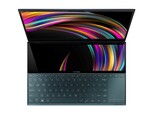Asus ZenBook Duo UX481FL
Especificaciones de Portátil(es)

Cámara principal: 0.9 MPix
Price comparison
Promedio de 6 puntuaciones (de 11 análisis)
Análisis para el Asus ZenBook Duo UX481FL
Asus quiere demostrar que hay otras formas de innovar además de crear los portátiles más finos año tras año. La pantalla del ScreenPad Plus es práctica e inestimable cuando está en su mejor momento, pero conlleva algunos inconvenientes ergonómicos.
Origen: Ricks Tech

Único Análisis, disponible online, Mediano, Fecha: 08/01/2022
Origen: Ricks Tech

Support, disponible online, Muy largo, Fecha: 07/20/2022
Origen: Ricks Tech

Support, disponible online, Muy largo, Fecha: 06/28/2022
Origen: It Pro
 EN→ES Archive.org version
EN→ES Archive.org versionAsus has pushed boundaries with the UX481, and there are areas where this machine succeeds. The primary screen offers good quality for sRGB work, and the lower panel is useful for secondary apps. The Asus has smart looks, solid performance and superb battery life. In key areas, though, the daring design means uncomfortable compromise. The cramped keyboard and trackpad can’t compare to Dell and Apple’s offerings, and the Asus is thicker and heavier than rivals. If you’re going to use the secondary screen, then you may be able to accept these issues. If it’s not going to be integral to your work, though, conventional laptops remain better.
Único Análisis, disponible online, largo, Fecha: 06/13/2020
Puntuación: Puntuación total: 60%
Origen: Engadget
 EN→ES Archive.org version
EN→ES Archive.org versionThe ZenBook Duo is a solid attempt at delivering a dual-screen ultraportable. Using both screens is intuitive, and it can be genuinely practical for multitasking. But ASUS had to make compromises to fit those screens, especially when it comes to the keyboard and trackpad. It’s also heavier and thicker than any other ultraportable.
Único Análisis, disponible online, largo, Fecha: 06/11/2020
Puntuación: Puntuación total: 81%
Origen: Engadget
 Archive.org version
Archive.org versionIf you're considering the ZenBook Duo, the real question you need to ask yourself is how much do you really need two screens on a $1,499 ultraportable. ASUS did a decent job of fitting in a second display, but it leads to plenty of compromises.
Único Análisis, disponible online, Mediano, Fecha: 06/10/2020
Origen: The Verge
 EN→ES Archive.org version
EN→ES Archive.org versionBut if you’re looking specifically for a two-screen device, this one works. It’s more than a party trick; it’s useful and there are cool things you can do. But I think the form factor is better suited to a workstation (like the ZenBook Pro Duo) which is likely to spend most of its life at a desk with peripherals plugged in. I’m not sure if there’s a way to make a Duo that’s also good at being a portable laptop. If there is, Asus hasn’t quite found it.
Único Análisis, disponible online, Muy largo, Fecha: 06/09/2020
Puntuación: Puntuación total: 70%
Origen: Trusted Reviews
 EN→ES Archive.org version
EN→ES Archive.org versionIf you’re going to benefit from the second screen – whether it’s in creative applications or just by bumping useful tools downwards – then the Duo is worth considering. If not, then more traditional notebooks remain better due to the number of design compromises Asus has had to make.
Único Análisis, disponible online, largo, Fecha: 05/18/2020
Puntuación: Puntuación total: 70%
Origen: Laptop Mag
 EN→ES Archive.org version
EN→ES Archive.org versionThe ZenBook Duo isn't as powerful as the ZenBook Pro Duo, but it delivers nearly all the same functionality at a significantly lower price. As a result, the Duo is a better option for all but the most demanding power users. First, you need to decide if the ZenBook Duo is right for you, or if a more traditional laptop, like the Samsung Galaxy Flex 15 or Lenovo Yoga C940 would be a better fit.
Único Análisis, disponible online, Muy largo, Fecha: 05/16/2020
Puntuación: Puntuación total: 80%
Origen: Mega Obzor
 RU→ES Archive.org version
RU→ES Archive.org versionÚnico Análisis, disponible online, Muy largo, Fecha: 05/04/2020
Origen: Zing
 VN→ES Archive.org version
VN→ES Archive.org versionÚnico Análisis, disponible online, largo, Fecha: 09/16/2020
Comentario
NVIDIA GeForce MX250:
Sucesora de la MX150 e aun basada en el mismo chip Pascal GP108 (similar a la GT 1030 de desktop) pero con velocidades más altas. Disponible en dos versiones, una versión normal de 25 Watts y una versión de baja potencia con TDP de 10 Watts y rendimiento reducido. La versión de 25 vatios, por ejemplo, ofrece una velocidad 21% más alta que la antigua MX150, lo que lleva a una ganancia de rendimiento del 5%.
Estas tarjetas también deben ser capaces de aguantar todos los juegos actuales, pero la mayoría de ellos en configuraciones de detalles medios y bajos y con bajas resoluciones. Juegos más antiguos, o menos exigentes todavía pueden ser jugados con buena calidad de gráficos.
>> Más información puede ser encontrada en nuestra comparación de tarjetas gráficas moviles y la lista de benchmarks.
i7-10510U:
Procesador de cuatro núcleos de baja potencia basado en Comet Lake (técnicamente idéntico a Whiskey Lake y aún producido en 14nm++). Los núcleos de CPU pueden registrar entre 1,8 y 4,9 GHz (los 4 núcleos 4,3 GHz máx.) con HyperThreading (8 threads). El controlador de memoria integrado es compatible con DDR4-2666 y con el uso de cTDP arriba/abajo, el OEM puede ajustar el rendimiento (10-25 Watts posible, 15W por defecto).
>> Más información puede ser encontrada en nuestra comparación de procesadores móviles.



